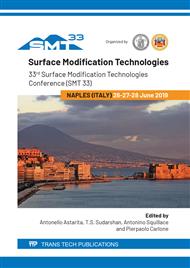[1]
G. Manivasagam, T. Lee, E. Mathew, S. Rajaraman, A. Singh, C.S. Lee, Tribological and corrosion behaviors of warm- and hot-rolled Ti-13Nb-13Zr alloys in simulated body fluid conditions, Int. J. Nanomedicine 10 (2015) 207.
DOI: 10.2147/ijn.s79996
Google Scholar
[2]
L.S. Toth, C. Gu, Ultrafine-grain metals by severe plastic deformation, Mater. Charact. 92 (2014) 1-14.
DOI: 10.1016/j.matchar.2014.02.003
Google Scholar
[3]
R.Z. Valiev, Y. Estrin, Z. Horita, T.G. Langdon, M.J. Zehetbauer, Y. Zhu, Producing Bulk Ultrafine-Grained Materials by Severe Plastic Deformation: Ten Years Later, Jom. 68 (2016) 1216–1226.
DOI: 10.1007/s11837-016-1820-6
Google Scholar
[4]
S. Liu, S.Y. Gao, Y.F. Zhou, X.L. Xing, X.R. Hou, Y.L. Yang, Q.X. Yang, A research on the microstructure evolution of austenite stainless steel by surface mechanical attrition treatment, Mater. Sci. Eng. A. 617 (2014) 127–138.
DOI: 10.1016/j.msea.2014.08.049
Google Scholar
[5]
M.A. Vasylyev, S.P. Chenakin, L.F. Yatsenko, Ultrasonic impact treatment induced oxidation of Ti6Al4V alloy, Acta Mater. 103 (2016) 761-774.
DOI: 10.1016/j.actamat.2015.10.041
Google Scholar
[6]
M.A. Vasylyev, S.P. Chenakin, L.F. Yatsenko, Nitridation of Ti-6Al-4V alloy under ultrasonic impact treatment in liquid nitrogen, Acta Mater. 60 (2012) 6223-6233.
DOI: 10.1016/j.actamat.2012.08.006
Google Scholar
[7]
S. Anand Kumar, R. Sundar, S. Ganesh Sundara Raman, H. Kumar, R. Kaul, K. Ranganathan, S.M. Oak, L.M. Kukreja, K.S. Bindra, Influence of laser peening on microstructure and fatigue lives of Ti-6Al-4V, Trans. Nonferrous Met. Soc. China 24 (2014) 3111-3117.
DOI: 10.1016/s1003-6326(14)63449-x
Google Scholar
[8]
S. Kumar, K. Chattopadhyay, V. Singh, Effect of ultrasonic shot peening on LCF behavior of the Ti–6Al–4V alloy, J. Alloys Compd. 724 (2017) 187–197.
DOI: 10.1016/j.jallcom.2017.07.014
Google Scholar
[9]
J. Marteau, M. Bigerelle, Relation between surface hardening and roughness induced by ultrasonic shot peening, Tribol. Int. 83 (2015) 105-113.
DOI: 10.1016/j.triboint.2014.11.006
Google Scholar
[10]
X.J. Cao, Y.S. Pyoun, R. Murakami, Fatigue properties of a S45C steel subjected to ultrasonic nanocrystal surface modification, Appl. Surf. Sci. 256 (2010) 6297–6303.
DOI: 10.1016/j.apsusc.2010.04.007
Google Scholar
[11]
T. Hanlon, Y.N. Kwon, S. Suresh, Grain size effects on the fatigue response of nanocrystalline metals, Scr. Mater. 49 (2003) 675–680.
DOI: 10.1016/s1359-6462(03)00393-2
Google Scholar
[12]
H. Mughrabi, H.W. Höppel, M. Kautz, Fatigue and microstructure of ultrafine-grained metals produced by severe plastic deformation, Scr. Mater. 51 (2004) 807–812.
DOI: 10.1016/j.scriptamat.2004.05.012
Google Scholar
[13]
M. Long, H.J. Rack, Titanium alloys in total joint replacement - A materials science perspective, Biomaterials. 19 (1998) 1621–1639.
DOI: 10.1016/s0142-9612(97)00146-4
Google Scholar
[14]
S.G. Steinemann, P.A. Mäusli, S. Szmukler-Moncler, M. Semlitsch, O. Pohler, H.E. Hintermann, S.M. Perren, Beta-titanium alloy for surgical implants, Seventh world conference on titanium, San Diego, USA, (1990).
Google Scholar
[15]
M. Geetha, A.K. Singh, K. Muraleedharan, A.K. Gogia, R. Asokamani, Effect of thermomechanical processing on microstructure of a Ti–13Nb–13Zr alloy, 329 (2001) 264–271.
DOI: 10.1016/s0925-8388(01)01604-8
Google Scholar
[16]
M. Niinomi, Mechanical properties of biomedical titanium alloys, Mater. Sci. Eng. A. 243 (1998) 231–236.
Google Scholar
[17]
M.A. Khan, R.L. Williams, D.F. Williams, The corrosion behaviour of Ti-6Al-4V, Ti-6Al-7Nb and Ti-13Nb-13Zr in protein solutions, Biomaterials. 20 (1999) 631–637.
DOI: 10.1016/s0142-9612(98)00217-8
Google Scholar
[18]
C.A.R.P. Baptista, S.G. Schneider, E.B. Taddei, H.M. Da Silva, Fatigue behavior of arc melted Ti-13Nb-13Zr alloy, Int. J. Fatigue. 26 (2004) 967–973.
DOI: 10.1016/j.ijfatigue.2004.01.011
Google Scholar
[19]
C.W. Lin, C.P. Ju, J.H. Chern Lin, A comparison of the fatigue behavior of cast Ti-7.5Mo with c.p. titanium, Ti-6Al-4V and Ti-13Nb-13Zr alloys, Biomaterials. 26 (2005) 2899–2907.
DOI: 10.1016/j.biomaterials.2004.09.007
Google Scholar
[20]
J.I. Langford, A.J.C. Wilson, Scherrer after sixty years: A survey and some new results in the determination of crystallite size, J. Appl. Crystallogr. 11 (1978) 102–113.
DOI: 10.1107/s0021889878012844
Google Scholar
[21]
L. Jin, W. Cui, X. Song, G. Liu, L. Zhou, Effects of surface nanocrystallization on corrosion resistance of β-type titanium alloy, Trans. Nonferrous Met. Soc. China. 24 (2014) 2529–2535.
DOI: 10.1016/s1003-6326(14)63379-3
Google Scholar
[22]
C. Zhang, W. Song, F. Li, X. Zhao, Y. Wang, G. Xiao, Microstructure and corrosion properties of Ti-6Al-4V alloy by ultrasonic shot peening, Int. J. Electrochem. Sci. 10 (2015) 9167–9178.
Google Scholar
[23]
M. Wen, G. Liu, J. Gu, W. Guan, J. Lu, Dislocation evolution in titanium during surface severe plastic deformation, Appl. Surf. Sci. 255 (2009) 6097–6102.
DOI: 10.1016/j.apsusc.2009.01.048
Google Scholar
[24]
X. Nie, W. He, L. Zhou, Q. Li, X. Wang, Experiment investigation of laser shock peening on TC6 titanium alloy to improve high cycle fatigue performance, Mater. Sci. Eng. A. 594 (2014) 161–167.
DOI: 10.1016/j.msea.2013.11.073
Google Scholar
[25]
L. Yang, N.R. Tao, K. Lu, L. Lu, Enhanced fatigue resistance of Cu with a gradient nanograined surface layer, Scr. Mater. 68 (2013) 801–804.
DOI: 10.1016/j.scriptamat.2013.01.031
Google Scholar
[26]
Q. Wang, Q. Sun, L. Xiao, J. Sun, Effect of Surface Nanocrystallization on Fatigue Behavior of Pure Titanium, J. Mater. Eng. Perform. 25 (2016) 241–249.
DOI: 10.1007/s11665-015-1819-0
Google Scholar
[27]
H.W. Huang, Z.B. Wang, J. Lu, K. Lu, Fatigue behaviors of AISI 316L stainless steel with a gradient nanostructured surface layer, Acta Mater. 87 (2015) 150–160.
DOI: 10.1016/j.actamat.2014.12.057
Google Scholar


